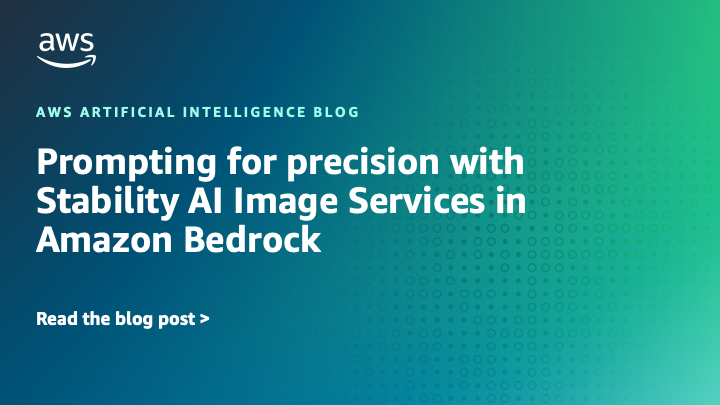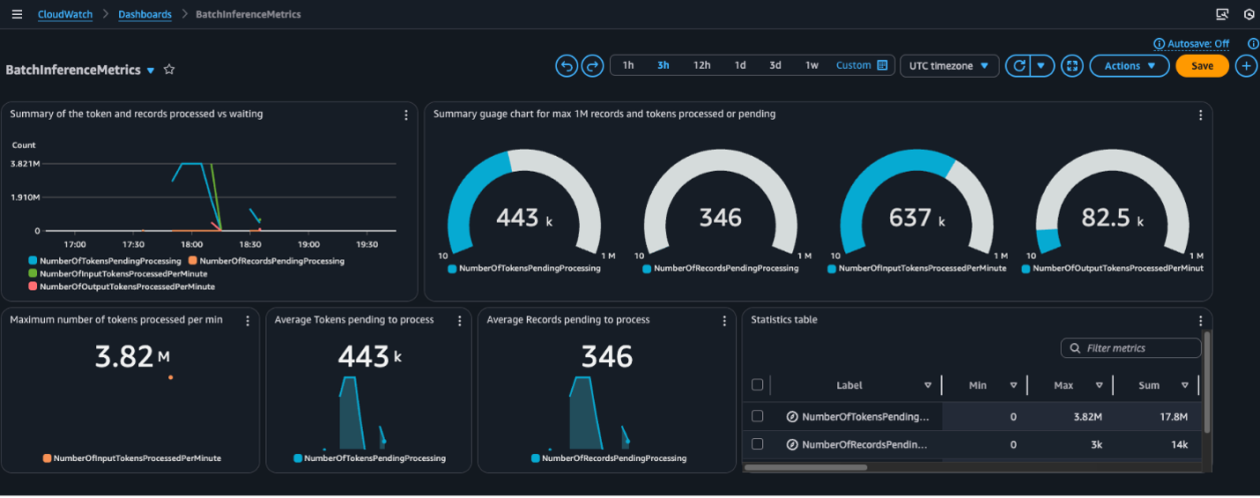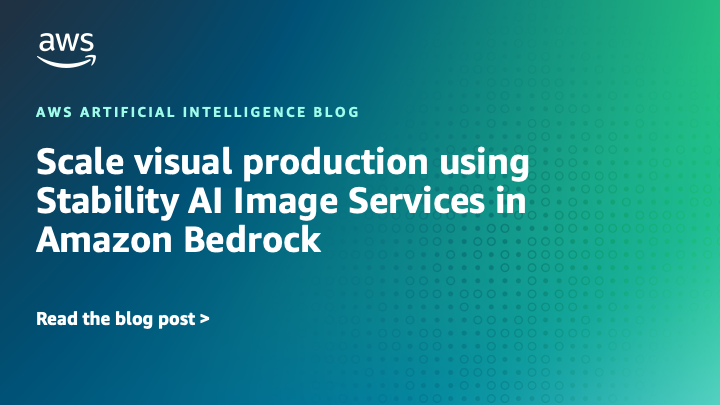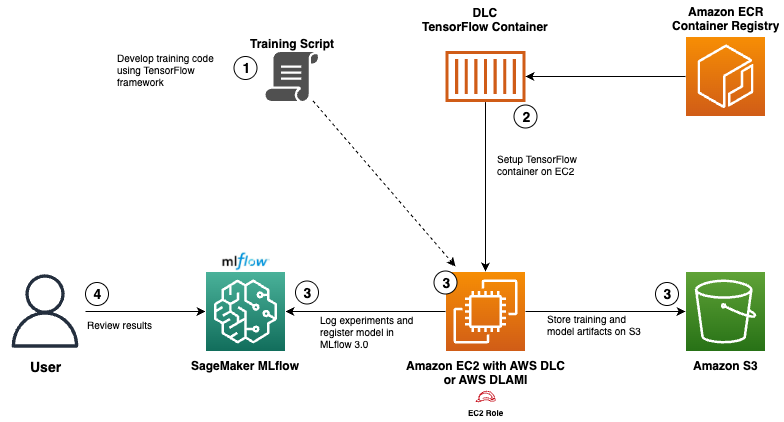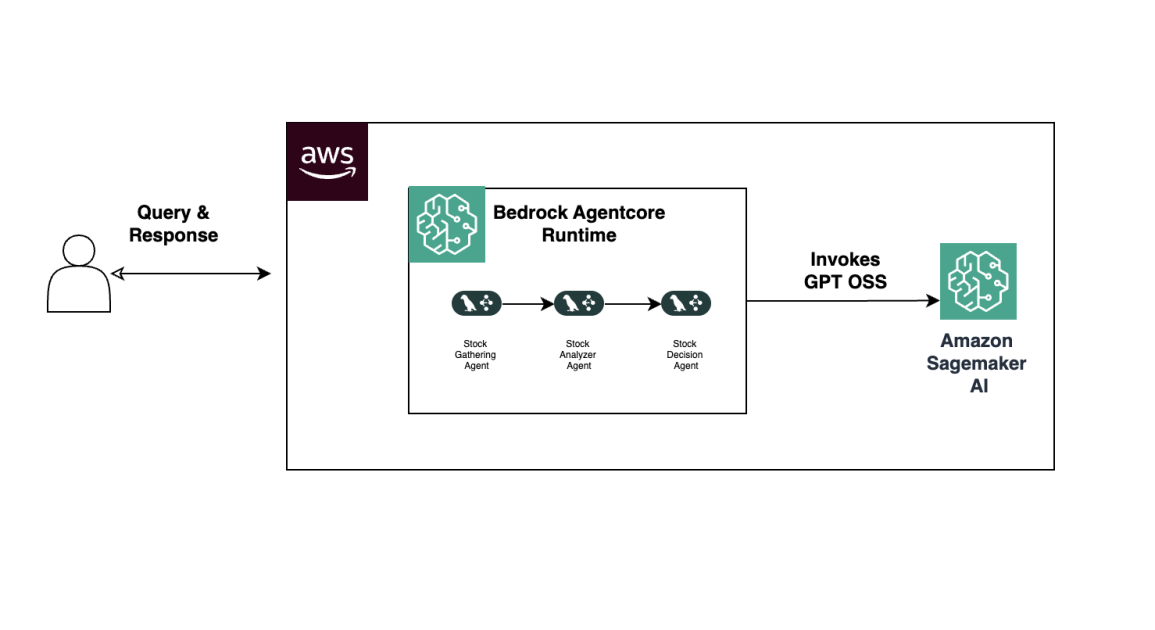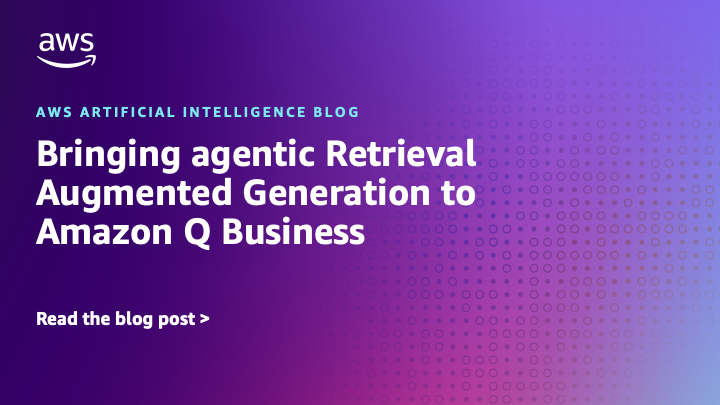
Bringing Agentic Retrieval Augmented Generation to Amazon Q Business
Sources: https://aws.amazon.com/blogs/machine-learning/bringing-agentic-retrieval-augmented-generation-to-amazon-q-business, aws.amazon.com
TL;DR
- Agentic RAG enables decomposition of complex queries, real-time visibility into processing steps, and multi-turn, context-aware conversations in Amazon Q Business.
- It leverages data navigation tools like tabular search and long context retrieval to ground AI responses in enterprise data while respecting existing permissions and providing clear citations.
- The approach uses AI agents that plan and execute sophisticated retrieval strategies, including clarifying questions for disambiguation and dynamic response optimization.
- Enable Agentic RAG in the Amazon Q Business web interface via the Advanced Search toggle to experience richer, more complete responses.
- This evolution aims to produce more accurate, nuanced, and complete answers for complex enterprise questions while preserving trust and speed.
Context and background
Amazon Q Business is a generative AI-powered enterprise assistant designed to help organizations unlock value from their data. By connecting to enterprise data sources, employees can quickly find answers, generate content, and automate tasks—from accessing HR policies to streamlining IT support workflows—while respecting existing permissions and providing clear citations AWS. At the heart of systems like Amazon Q Business lies Retrieval Augmented Generation (RAG), which grounds AI model responses in an organization’s data. Traditional RAG typically follows a single-shot retrieval approach: retrieve relevant documents or passages for a user query, then generate a response using those materials as context for the large language model (LLM). This approach works for straightforward, factual questions but struggles with the complex, multi-source, context-rich questions common in enterprise environments. Queries like comparing two benefits packages or analyzing project outcomes across multiple quarters require synthesizing information from multiple sources, understanding company-specific context, and often numerous retrieval steps. Traditional RAG can yield incomplete answers and lacks visibility into the retrieval process, leaving users with an opaque experience AWS. Bringing agency to Amazon Q Business introduces Agentic RAG, a new paradigm that uses intelligent AI agents to plan and execute sophisticated retrieval strategies with a suite of data navigation tools. This approach aims to deliver more accurate and comprehensive responses while maintaining the speed users expect. Agentic RAG offers capabilities such as query decomposition, transparent events, agentic retrieval tool use, improved conversational capabilities, and agentic response optimization AWS. The release emphasizes that Agentic RAG can decompose complex questions (for example, decomposing a request to compare Washington and California vacation policies into separate queries for each state) and provide real-time visibility into processing steps as data is retrieved. After the response is generated, steps are collapsed with the final answer. The blog describes how decomposed queries and retrieved data are synthesized by the LLM to present a coherent, richly formatted result AWS. Agentic RAG’s design enables multi-turn, context-aware dialogues, with memory for short-term conversation context, allowing natural follow-ups without repeating prior context. When ambiguity arises, the agent can ask clarifying questions to disambiguate the user’s intent, improving accuracy and relevance across successive turns. The capability to persist conversation state and retrieved context in memory supports precisely targeted responses as the dialogue evolves AWS. The blog also highlights that Agentic RAG uses a range of retrieval tools — including tabular search for data extraction and organization, and long context retrieval to fetch complete documents when extensive context is required (for example, summarizing a 10-K filing). These tools enable intelligent, context-aware data exploration and are deployed by the agent as part of an optimal retrieval plan, all while respecting enterprise data formats like DOCX, PPTX, PDF, CSV, and XLSX AWS. In practice, the Agentic RAG workflow involves the agent planning retrieval steps, maintaining context across turns, and re-planning as needed to improve completeness. The system can surface progress during processing and later summarize the actions taken to reach the final answer, providing users with transparency into how the result was derived AWS.
What’s new
- Decomposed queries: When faced with complex questions, the agent intelligently breaks them into discrete components. Example: a request like “Please compare the vacation policies of Washington and California?” is split into two targeted queries (Washington state vacation policies and California state vacation policies) to gather precise data for synthesis.
- Real-time processing visibility: The system displays processing steps on screen as data is retrieved and used to generate the response; after completion, these steps collapse with the final answer, improving transparency AWS.
- Agentic retrieval tool use: The agent can deploy a suite of data exploration tools, selecting the most appropriate retrieval method for the task at hand, including tools built into Amazon Q Business such as tabular search and long context retrieval AWS.
- Improved conversational capabilities: Multi-turn, context-aware dialogues maintain conversational context across interactions via short-term memory, enabling natural follow-ups without re-stating prior context AWS.
- Agentic response optimization: The agent continuously evaluates response quality and re-plans actions to improve information completeness, especially for topics with interdependencies or nuanced requirements (e.g., compliance policies) AWS.
- Enablement via Advanced Search: To begin using Agentic RAG, users can switch on the Advanced Search toggle in the Amazon Q Business web interface, enabling richer and more complete responses AWS.
A glimpse of how it works
The designed RAG agents can intelligently deploy various data exploration tools and retrieval methods in an optimal sequence while maintaining context over multiple turns. Retrieval tools include tabular search (supporting data extraction or tabular linearization across small and large tables embedded in documents or stored in CSV/XLSX) and long context retrieval (fetching full documents when required, such as a company’s 10-K) to ground the LLM’s response in complete context. This approach represents a significant advancement over traditional RAG, which often relies on fragmented passages and may compromise coherence for complex document analysis AWS. The blog provides a concrete example of multi-turn breakdown: decomposed queries enable sequential data gathering and synthesis (e.g., separate data pulls for California and Washington policies) and a consolidated response presented in rich markdown format. The agent also handles disambiguation by recognizing potential interpretations of terms (for example, “Q”) and asking clarifying questions to verify intent before proceeding AWS. In addition to memory and clarifying questions, Agentic RAG maintains the conversation history and relevant retrieved data in memory, allowing precise, targeted responses once intent is clarified. The overall design supports breaking down complex topics (such as cross-region performance comparisons or policy implications across departments) into manageable search tasks while preserving context across turns AWS.
Why it matters (impact for developers/enterprises)
- More accurate and complete answers for complex, multi-source queries: By decomposing questions and orchestrating multiple retrieval steps, Agentic RAG delivers nuanced results that reflect enterprise data, interdependencies, and context AWS.
- Transparent, auditable workflows: Real-time visibility into processing steps and the ability to see how results are generated increase user trust and provide insight into the AI’s reasoning process AWS.
- Enhanced user experience for complex tasks: Multi-turn dialogues, short-term memory, and clarifying questions enable more natural, productive conversations about policies, performance, or troubleshooting across departments AWS.
- Grounded in enterprise data with clear citations: Responses are grounded in enterprise data sources with citations, supporting accountability and compliance requirements AWS.
- Flexible data navigation and document handling: The system can fetch data across various formats (DOCX, PPTX, PDF, CSV, XLSX) and summarize or extract relevant context as needed, enabling richer insights AWS.
Technical details or Implementation
Agentic RAG in Amazon Q Business introduces a set of capabilities that extend traditional retrieval-then-generation loops:
- Query decomposition: Complex questions are broken into discrete components that guide targeted data retrieval and synthesis.
- Real-time processing visibility: The UI displays the agent’s retrieval and reasoning steps as they occur, with steps collapsing after the final answer is produced, providing transparency into how results are generated AWS.
- Agentic retrieval tool use: The agent can select and deploy multiple retrieval tools from a toolbox within Amazon Q Business, choosing the most appropriate method for the task at hand.
- Data navigation tools:
- Tabular search: Enables intelligent retrieval of data through code generation or tabular linearization across small and large tables embedded in documents or stored in CSV/XLSX files.
- Long context retrieval: Determines when a full document context is required (e.g., Summarize the 10-K of Company X) and retrieves the complete document for grounding the LLM’s response AWS.
- Multi-turn, context-aware dialogues: The agent maintains conversational context across interactions by storing short-term memory, enabling natural follow-ups without re-stating prior context AWS.
- Clarifying questions for disambiguation: When multiple interpretations are possible, the agent asks clarifying questions to better understand what the user wants and to improve accuracy AWS.
- Dynamic response optimization: The agent continually evaluates response quality and re-plans actions to improve completeness, capturing updates, exceptions, and interdependencies in complex topics like compliance or policy reviews AWS.
- Enablement and usage: In the Amazon Q Business web interface, switch on the Advanced Search toggle to enable Agentic RAG and access richer, more complete responses immediately AWS. The implementation supports enterprise data formats such as DOCX, PPTX, PDF, CSV, and XLSX, and uses tools like tabular search and long context retrieval to ground responses in the appropriate data sources. This approach provides a coherent synthesis across multiple sources and turns complex questions into a sequence of guided retrieval tasks that preserve context across turns AWS.
Key table: Traditional RAG vs Agentic RAG (high level)
| Data handling and retrieval | Traditional RAG | Agentic RAG |---|---|---| | Retrieval strategy | Single-shot retrieval with context built from retrieved passages | Decomposed, multi-turn planning with sequential retrieval steps |Processing visibility | Not described or exposed during processing | Real-time visibility of processing steps displayed to the user |Data navigation tools | Not specified in the source | Includes tabular search and long context retrieval |Context handling | Limited to current turn, less memory across turns | Maintains conversational context with short-term memory |Clarification handling | Limited or no explicit disambiguation | Asks clarifying questions to disambiguate multi-interpretive queries |Response optimization | Static, based on initial retrieval | Dynamic, iterative planning to improve completeness |
Key takeaways
- Agentic RAG provides a structured approach to complex enterprise queries by decomposing them into discrete tasks and planning retrieval steps.
- Real-time visibility into the retrieval process helps users understand how answers are formed and increases trust in the results.
- A combination of data navigation tools (tabular search and long context retrieval) grounds responses in the enterprise data landscape and supports diverse document formats.
- Multi-turn context, memory, and clarification questions enable more accurate, nuanced, and complete answers for policy interpretation, technical troubleshooting, and cross-department analyses.
- Enabling Agentic RAG is straightforward through the Advanced Search toggle in the Amazon Q Business interface, opening up richer, more complete responses for complex questions AWS.
FAQ
-
What is Agentic RAG in Amazon Q Business?
It is an agent-based retrieval approach that plans and executes sophisticated retrieval strategies, decomposes complex queries, maintains context across turns, and optimizes responses dynamically to ground answers in enterprise data [AWS](https://aws.amazon.com/blogs/machine-learning/bringing-agentic-retrieval-augmented-generation-to-amazon-q-business).
-
How does it handle complex queries differently from traditional RAG?
It decomposes queries into discrete parts, uses multi-step retrieval, provides real-time progress visibility, and synthesizes data from multiple sources into a complete answer while maintaining context [AWS](https://aws.amazon.com/blogs/machine-learning/bringing-agentic-retrieval-augmented-generation-to-amazon-q-business).
-
How can I enable Agentic RAG in Amazon Q Business?
In the Amazon Q Business web interface, switch on the Advanced Search toggle to enable Agentic RAG, which provides richer and more complete responses [AWS](https://aws.amazon.com/blogs/machine-learning/bringing-agentic-retrieval-augmented-generation-to-amazon-q-business).
-
What data tools are involved in Agentic RAG?
Tools include tabular search for data extraction or tabularization and long context retrieval to fetch full documents as needed (e.g., a 10-K) to ground the LLM’s response [AWS](https://aws.amazon.com/blogs/machine-learning/bringing-agentic-retrieval-augmented-generation-to-amazon-q-business).
References
More news
Move AI agents from proof of concept to production with Amazon Bedrock AgentCore
A detailed look at how Amazon Bedrock AgentCore helps transition agent-based AI applications from experimental proof of concept to enterprise-grade production systems, preserving security, memory, observability, and scalable tool management.
Prompting for precision with Stability AI Image Services in Amazon Bedrock
Amazon Bedrock now offers Stability AI Image Services, extending Stable Diffusion and Stable Image with nine tools for precise image creation and editing. Learn prompting best practices for enterprise use.
Monitor Amazon Bedrock batch inference using Amazon CloudWatch metrics
Learn how to monitor and optimize Amazon Bedrock batch inference jobs with CloudWatch metrics, alarms, and dashboards to improve performance, cost efficiency, and operational oversight.
Scale visual production using Stability AI Image Services in Amazon Bedrock
Stability AI Image Services are now available in Amazon Bedrock, delivering ready-to-use media editing via the Bedrock API and expanding on Stable Diffusion models already in Bedrock.
Use AWS Deep Learning Containers with Amazon SageMaker AI managed MLflow
Explore how AWS Deep Learning Containers (DLCs) integrate with SageMaker AI managed MLflow to balance infrastructure control and robust ML governance. A TensorFlow abalone age prediction workflow demonstrates end-to-end tracking, model governance, and deployment traceability.
Build Agentic Workflows with OpenAI GPT OSS on SageMaker AI and Bedrock AgentCore
An end-to-end look at deploying OpenAI GPT OSS models on SageMaker AI and Bedrock AgentCore to power a multi-agent stock analyzer with LangGraph, including 4-bit MXFP4 quantization, serverless orchestration, and scalable inference.

